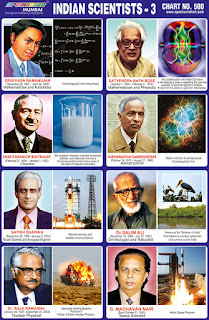 |
| Indian Scientists 3 Chart |
Spectrum Chart - 500 : Indian Scientists 3
1. Srinivasa Ramanujan (Mathematician &
Autodidact) - Srinivasa Ramanujan was an Indian mathematician and
autodidact. Though he had almost no formal training in pure
mathematics, he made extraordinary contributions to mathematical
analysis, number theory, infinite series and continued fractions.
During his short life, Ramanujan independently compiled nearly 3,900
results. Nearly all his claims have now been proven correct.
2. Satyendra Nath Bose (Mathematician &
Physicist) - Satyendra Nath Bose was a Bengali physicist specialising
in mathematical physics. He is best known for his work on quantum
mechanics in the early 1920's, providing the foundation for
Bose–Einstein statistics and the theory of the Bose–Einstein
condensate. A self-taught scholar and a polyglot, he had a wide range
of interests in varied fields including physics, mathematics,
chemistry, biology, mineralogy, philosophy, arts, literature and
music. He served on many research and development committees in
sovereign India.
3. Shanti Swaroop Bhatnagar (Chemist) -
Shanti Swaroop Bhatnagar was a well-known Indian scientist, a
professor of chemistry for over 19 years. He was the first
director-general of the Council of Scientific and Industrial Research
(CSIR) and he is revered as the father of research laboratories. He
was also the first Chairman of the University Grants Commission
(UGC). His major innovation was improving the procedure for drilling
crude oil.
4. Subrahmanyan Chandrasekhar
(Astrophysicist) - Subrahmanyan Chandrasekhar, was an Indian American
astrophysicist who was awarded the 1983 Nobel Prize for Physics with
William A. Fowler "for his theoretical studies of the physical
processes of importance to the structure and evolution of the stars".
His mathematical treatment of stellar evolution yielded many of the
best current theoretical models of the later evolutionary stages of
massive star and black holes. The Chandrasekhar limit is named after
him.
5. Satish Dhawan (Rocket Scientist &
Aerospace Engineer) - Satish Dhawan was an Indian aerospace engineer,
widely regarded as the father of experimental fluid dynamics research
in India. Dhawan was one of the most eminent researchers in the field
of turbulence and boundary layers, leading the successful and
ingenious development of the Indian space programme. Prof. Satish
Dhawan carried out pioneering experiments in rural education, remote
sensing and satellite communications. His efforts led to operational
systems like INSAT- a telecommunications satellite, IRS - the Indian
Remote Sensing satellite and the Polar Satellite Launch Vehicle
(PSLV) that placed India in the league of space faring nations.
6. Dr. Salim Ali (Ornithologist &
Naturalist) – Dr. Salim Ali was an Indian ornithologist and
naturalist. Sometimes referred to as the "birdman of India",
Salim Ali was among the first Indians to conduct systematic bird
surveys across India and several bird books that he wrote helped
popularise ornithology in India. Several species of birds and a
couple of bird sanctuaries and institutions have been named after
him.

No comments:
Post a Comment